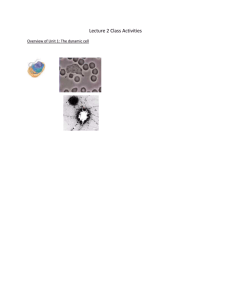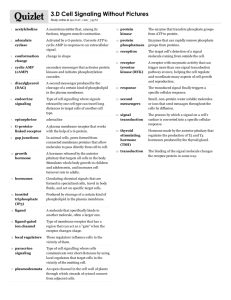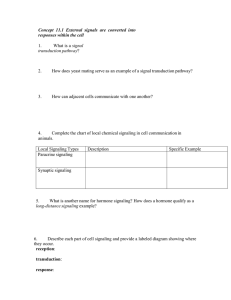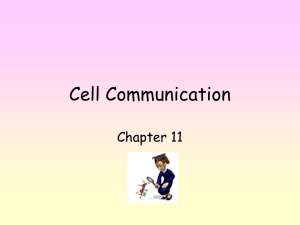Cell Communication: Signal Transduction Pathways
advertisement
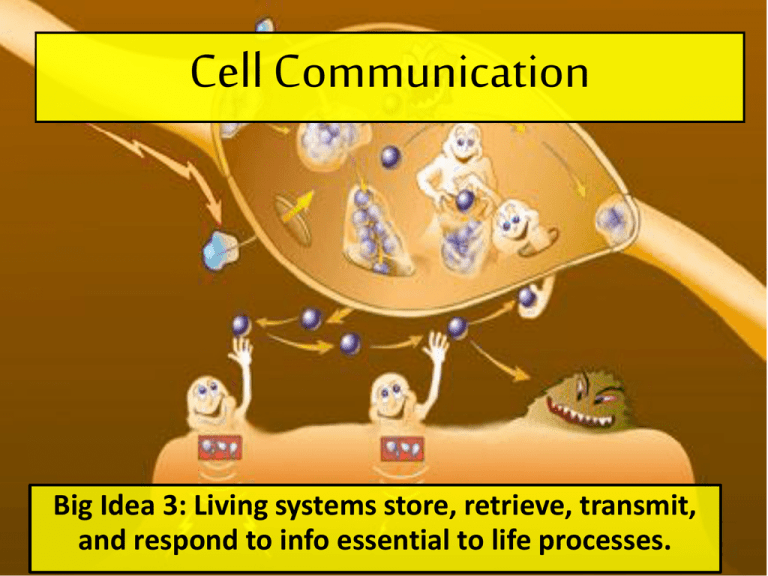
Cell Communication Big Idea 3: Living systems store, retrieve, transmit, and respond to info essential to life processes. Essential Knowledge • 3D1: Cell communication processes share common features that reflect evolutionary history. • 3D2: Cells communicate with each other through direct contact with other cells or from a distance via chemical signaling. • 3D3: Signal transduction pathways link signal reception with cellular response. • 3D4: Changes in signal transduction pathways can alter cellular responses. Simple Communication Stimulatory •Activate some sort of behavior, activity, gene expression etc. Inhibitory •Shut off behavior, activity, gene expression etc. Origin of Cell Signaling •Began as way for single celled orgs to “communicate” w/ each other •Ex: when it gets crowded bacteria can send signals to shut off reproduction (quorum sensing) •Has been conserved throughout evolution Purpose of Signaling in Multi-Cellular Organisms •Coordinate cellular actions •Ex: when frightened you release epinephrine, which triggers mobilization of glucose and other energy resources •Fight or flight Distance of Communication 1) Direct contact 2) Local communication 3) Long distance Example of Direct Contact • Plant cells walls have plasmodesmata which allow material to be transported b/t cells. Example of Direct Contact •Antigenpresenting White blood cell directly contacts helper T cells •Activates immune responses Example of Local Regulation •Neurotransmitters (chem messengeres in b/t neurons) •Serotonin, dopamine etc. carry signals from one part of brain to others •Only affects cells in local area Example of Long Distance Signaling • Hormones • Released from endocrine glands and travel through blood • Affect many target cells throughout the body Step 1: Reception • Signal molecule (aka ligand) binds to a receptor protein change shape • Highly specific • Most signal receptors are proteins Types of Receptors on Plasma Membrane • Type 1: G protein-coupled receptor: membrane receptor that works w/ help of a G protein…(how gangsta!) • G protein acts as an on/off switch: If GDP is bound to G protein G protein is inactive • http://highered.mcgrawhill.com/sites/0072507470/student_view0/chap ter17/animation__membranebound_receptors_that_activate_g_proteins.html G Proteins and Medicine Diabetes, blindness, allergies, depression and some cancers are believed to come from dysfunctional G proteins Up to 60% of medicines used influence GProtein Pathways Types of Receptors on Plasma Membrane • Type 2: Receptor tyrosine kinases: membrane receptors that attach phosphates to tyrosines (a.acids) • Can trigger multiple signal pathways at once Types of Receptors on Plasma Membrane • Type 3: Ligandgated ion channel receptor acts as a gate when receptor changes shape Intracellular Receptors • Some receptor proteins are found in cytosol/nucleus of target cells • Small/hydrophobic chemical messengers can readily cross membrane and activate receptors Ex: hormones! http://highered.mcgrawhill.com/sites/0072507470/student_view0/chapter17/animation__intracellular_receptor_m odel.html Fig. 11-8-1 Hormone (testosterone) EXTRACELLULAR FLUID Plasma membrane Receptor protein DNA NUCLEUS CYTOPLASM Fig. 11-8-2 Hormone (testosterone) EXTRACELLULAR FLUID Plasma membrane Receptor protein Hormonereceptor complex DNA NUCLEUS CYTOPLASM Fig. 11-8-3 Hormone (testosterone) EXTRACELLULAR FLUID Plasma membrane Receptor protein Hormonereceptor complex DNA NUCLEUS CYTOPLASM Fig. 11-8-4 Hormone (testosterone) EXTRACELLULAR FLUID Plasma membrane Receptor protein Hormonereceptor complex DNA mRNA NUCLEUS CYTOPLASM Fig. 11-8-5 Hormone (testosterone) EXTRACELLULAR FLUID Plasma membrane Receptor protein Hormonereceptor complex DNA mRNA NUCLEUS CYTOPLASM New protein Step 2: Transduction • Multiple steps • Can amplify a signal! • Relayers are mainly proteins • Domino effect! Protein Phosphorylation and Dephosphorylation • Signal passed by a cascade of protein phosphorylations • Protein kinases transfer PO4’s from ATP to protein (phosphorylation) • Protein phosphatases remove PO4’s from proteins (dephosphorylation) Fig. 11-9 Signaling molecule Receptor Activated relay molecule Inactive protein kinase 1 Active protein kinase 1 Inactive protein kinase 2 ATP ADP Pi P Active protein kinase 2 PP Inactive protein kinase 3 ATP ADP Pi Active protein kinase 3 PP Inactive protein P ATP P ADP Pi PP Active protein Cellular response Second Messengers • 1st messenger: bound onto cell membrane • 2nd messengers: small, nonprotein, water-soluble molecules that spread t/out a cell by diffusion • Exs: Cyclic AMP and Ca+2 ions Cyclic AMP • Cyclic AMP (cAMP): most widely used 2nd messenger • Adenylyl cyclase: enzyme in plasma membrane, converts ATP to cAMP in response to an extracellular signal • http://highered.mcgrawhill.com/sites/0072507470/student_view0/chap ter17/animation__second_messenger__camp.ht ml Fig. 11-10 Adenylyl cyclase Phosphodiesterase Pyrophosphate P ATP Pi cAMP AMP Fig. 11-11 First messenger Adenylyl cyclase G protein G protein-coupled receptor GTP ATP cAMP Second messenger Protein kinase A Cellular responses Step 3: Response • AKA: “output response” • Usually activates transcription to make a protein or to regulate enzyme activity. Importance of Cell Signaling • Diseases result from incorrect signaling • Drugs often target signaling mechanisms • Poisons and pesticides often target signaling pathways Mr. Anderson Cell Signaling

